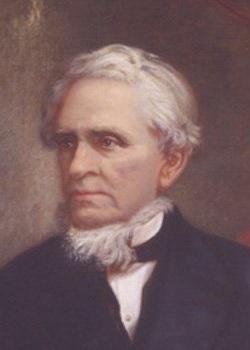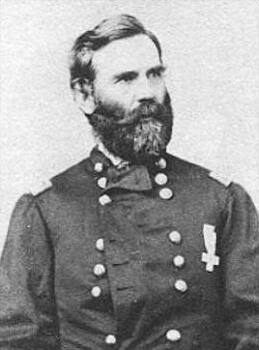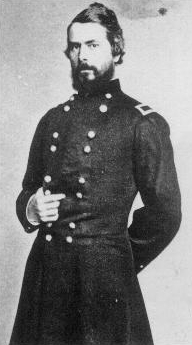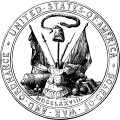Related Research Articles

The Army of Northern Virginia was the primary military force of the Confederate States of America in the Eastern Theater of the American Civil War. It was also the primary command structure of the Department of Northern Virginia. It was most often arrayed against the Union Army of the Potomac.

John Adams Dix was an American politician and military officer who was Secretary of the Treasury, Governor of New York and Union major general during the Civil War. He was notable for arresting the pro-Southern Maryland General Assembly, preventing that divided border state from seceding, and for arranging a system for prisoner exchange via the Dix–Hill Cartel, concluded in partnership with Confederate Major General Daniel Harvey Hill.

The Battle of Monocacy was fought on July 9, 1864, about 6 miles (9.7 km) from Frederick, Maryland, as part of the Valley Campaigns of 1864 during the American Civil War. Confederate forces under Lt. Gen. Jubal A. Early defeated Union forces under Maj. Gen. Lew Wallace. The battle was part of Early's raid through the Shenandoah Valley and into Maryland in an attempt to divert Union forces from their siege of Gen. Robert E. Lee's army at Petersburg, Virginia.

Daniel Harvey Hill, commonly known as D. H. Hill, was a Confederate general who commanded infantry in the eastern and western theaters of the American Civil War.

There were two corps of the Union Army called IV Corps during the American Civil War. They were separate units, one serving with the Army of the Potomac and the Department of Virginia in the Eastern Theater, 1862–1863, the other with the Army of the Cumberland in the Western Theater, 1863–1865.

The VIII Corps was a corps of the Union Army during the American Civil War.

XXII Corps was a corps in the Union Army during the American Civil War. It was created on February 2, 1863, to consist of all troops garrisoned in Washington, D.C., and included three infantry divisions and one of cavalry. Many of its units were transferred to the Army of the Potomac during Grant's Overland Campaign.

The Maryland campaign occurred September 4–20, 1862, during the American Civil War. The campaign was Confederate General Robert E. Lee's first invasion of the North. It was repulsed by the Army of the Potomac under Maj. Gen. George B. McClellan, who moved to intercept Lee and his Army of Northern Virginia and eventually attacked it near Sharpsburg, Maryland. The resulting Battle of Antietam was the bloodiest day of battle in American history.

John Cleveland Robinson was an American soldier in the United States Army. Robinson had a long and distinguished military career, fighting in many wars and culminating his career as a brigadier general and brevet major general in the Union Army during the American Civil War.

George Washington Getty was a career military officer in the United States Army, most noted for his role as a division commander in the Army of the Potomac during the final full year of the American Civil War.

George Henry Gordon was an American lawyer and a Union general in the American Civil War.

Truman Seymour was a career soldier and an accomplished painter. He served in the Union Army during the American Civil War, rising to the rank of major general. He was present at the Battle of Fort Sumter. He commanded the Union troops at the Battle of Olustee, the only major Civil War battle fought in Florida.
The Department of the Ohio was an administrative military district created by the United States War Department early in the American Civil War to administer the troops in the Northern states near the Ohio River.

Absalom Baird was a career United States Army officer who distinguished himself as a Union Army general in the American Civil War. Baird received the Medal of Honor for his military actions.

Henry Hayes Lockwood was an American soldier and academic from Delaware who rose to the rank of Brigadier General during the American Civil War, captured the Delmarva Peninsula including Virginia's Eastern Shore and headed the Union Middle Department in Baltimore before returning to academic life at the U.S. Naval Academy in Annapolis, Maryland.
The Department of Virginia and North Carolina was a United States Military department encompassing Union-occupied territory in the Confederate States during the Civil War. In 1863 it was formed by the merging of two previously existing departments: the Department of Virginia and the Department of North Carolina. In 1865 the two departments were once again separated.
The following Union Army units and commanders were the initial structure on April 4, 1862 of the Union Department of the Potomac during the Peninsula campaign of the American Civil War. This list includes units deployed to the Virginia Peninsula, and those that remained in the Washington area. The Confederate order of battle is listed separately.
During the American Civil War, a department was a geographical command within the Union's military organization, usually reporting directly to the War Department. Many of the Union's departments were named after rivers or other bodies of water, such as the Department of the Potomac and the Department of the Tennessee. The geographical boundaries of such departments changed frequently, as did their names. As the armies became larger Departments began to be subordinated to Military Divisions, and the Departments were often sub divided into Districts and from 1862 Subdistricts. Much information on Civil War departments can be found in Eicher & Eicher, Civil War High Commands.
William Walton Morris Jr. was an American soldier and a career officer in the United States Army. He served as a colonel and brevet brigadier general in the Regular Army, with Union Army service during the American Civil War (1861–1865). Morris served as a brigade commander primarily in charge of the defense of Fort McHenry and Baltimore Harbor. He had several brief periods in command of VIII Corps and of the Middle Department, which almost completely overlapped with each other.
The 5th Maryland Volunteer Infantry Regiment was an infantry regiment that served in the Union Army during the American Civil War.
References
- Eicher, John H., and Eicher, David J., Civil War High Commands, Stanford University Press, 2001, ISBN 0-8047-3641-3.
- U.S. War Department, The War of the Rebellion: a Compilation of the Official Records of the Union and Confederate Armies, U.S. Government Printing Office, 1880–1901.
